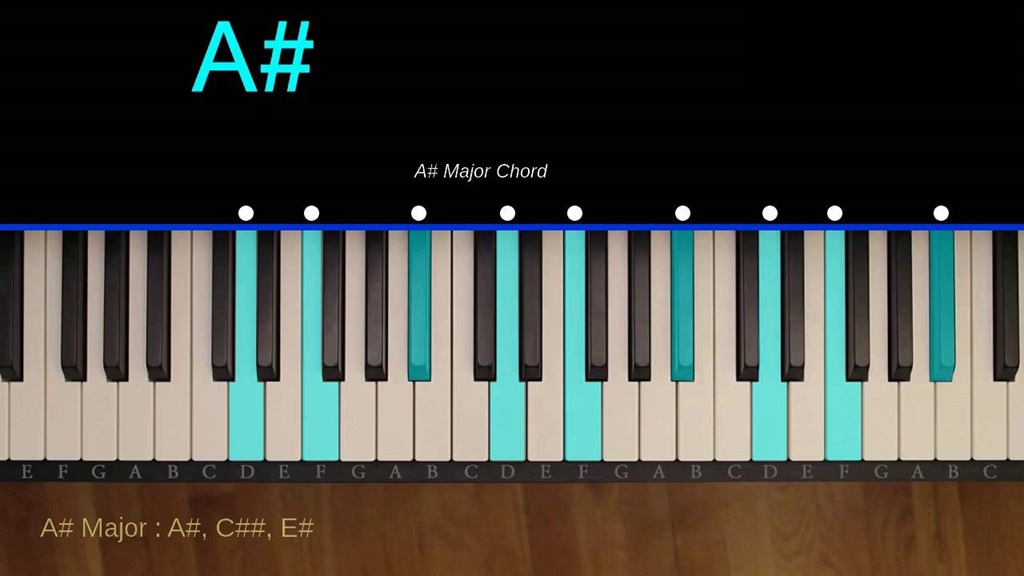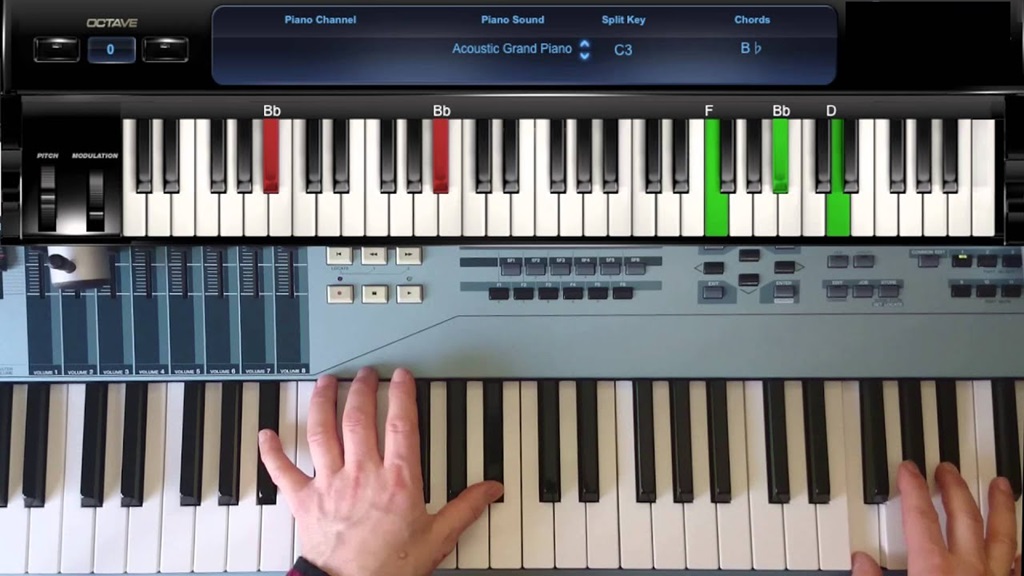How to Play A# Piano Chord Inversions and Progressions
For musicians with advanced piano skills, incorporating A# chords into their repertoire can greatly enhance the harmonic complexity and melodic accompaniment of their playing. The A# chord serves as a fundamental component for playing in keys such as D# minor and can enhance the tonal color of a piece when utilized as a secondary dominant. By mastering the underlying music theory and technical nuances of A# piano chord through consistent practice, pianists can unlock a versatile and dynamic range of possibilities for their performances.
Getting Started with A# Piano Chords
Before diving into playing A# piano chord inversions and progressions, it’s helpful to ensure you have the music theory fundamentals down. Here’s a quick primer on building A# chords:
- The A# note is the black key to the right of the group of two black keys on a keyboard
- A# major chords are built by taking the root (A#), the major third (C#), and the perfect fifth (E#)
- A# minor chords use the root (A#), minor third (C#), and perfect fifth (E#)
- A# chords can also be built as augmented, diminished, sus2, sus4, 7th chords, and more
When reading A# chords in sheet music, you may see just “A#” for a major chord or “A#m” for a minor. Pay attention to accidentals that affect the C# and E# notes as well. Now, let’s get to playing!
Playing A# Triad Inversions
Triad inversions involve rearranging the three notes of a chord so that a different note becomes the lowest bass note. Here are the three inversions of both A# major and A# minor triads:
A# Major Inversions
- Root position: A# is lowest note. Right hand plays C#-E#-A# spanning multiple octaves.
- 1st Inversion: C# becomes bass note. Right hand plays E#-A#-C#.
- 2nd Inversion: E# is lowest note. Right hand plays A#-C#-E#.
A# Minor Inversions
- Root Position: A# lowest note. Right hand plays C#-E#-A#.
- 1st Inversion: C# becomes bass. Right hand plays E#-A#-C#.
- 2nd Inversion: E# is lowest note. Right hand plays A#-C#-E#.
When playing these inversions, focus on keeping the bass note steady while the right hand moves in block chord formations. You can practice playing up and down the keyboard to get used to the feel.
Adding Seventh Chords

One way to make A# chords even more interesting is by adding a seventh – making it an A# dominant 7 (A#7) or A# minor 7 (A#m7) chord. Here is how to build those chords on piano:
A# Dominant Seventh Chord
The A#7 chord adds the flatted seventh note (G#) to the root, third, and fifth of the A# triad.
Root position: Right hand plays C#-E#-G#-A# spanning octaves. Bass plays A#.
Inversions:
- 1st Inversion: Bass plays C# while right hand plays E#-G#-A#-C#.
- 2nd Inversion: Bass E#, right plays G#-A#-C#-E#
- 3rd Inversion: Bass plays G#, right hand plays A#-C#-E#-G#.
A# Minor Seventh Chord
The A# minor seventh (A#m7) chord adds the flatted seventh note (G#) to a minor triad.
Root position: Right hand plays C#-E#-G#-A#. Bass plays A#.
Inversions:
- 1st Inversion: Bass plays C#, right hand plays E#-G#-A#-C#.
- 2nd Inversion: E# bass note, right hand is G#-A#-C#-E#.
- 3rd Inversion: Bass G#, right hand A#-C#-E#-G#.
To effectively practice playing through both the A#7 and A#m7 chords, it is recommended to first focus on playing them as triads. This will help you get comfortable with the basic chord structure and the positioning of each note. As you play, pay close attention to the stability of the bass note and ensure a steady rhythm in your right hand. Once you feel confident playing the triads, you can then add the seventh note to each chord. This approach will help you build a strong foundation for playing these chords and improve your overall technique and musicality.
Building Chord Progressions with A# Chords
One of the most exciting parts of learning new chords is starting to use them in chord progressions. Here are some tips for utilizing A# major and minor chords in piano chord progressions:
- Use as a minor chord (vi) in D# minor key progressions
- Works as the III chord in F# major sequences
- Functions as a secondary dominant to D#m chords (V/ii)
- Adds color and harmonic variety to basic pop/rock chord patterns
Here are some sample chord progressions with A# chords:
- D#m – A#m – G#m – D#m
- F# – A# – B – F#
- A – E – C#m – A#m – D#m
- F# – A# – D#m – D#m/A# (with A# bass note)
As you get comfortable using these progressions, try experimenting with adding inversions, seventh chords, arpeggios, melodies, and left-hand patterns. Use chorales, praise songs, or improvisation to get creative with A# chord progressions on piano.
Tips for Practicing and Developing Proficiency

Learning new chords takes focused practice and repetition. Be patient with yourself! Here are some tips:
- Start slowly and correctly: Perfect the hand shape, notes, and fingerings before worrying about speed.
- Separate hands if needed: Master the left hand bass pattern separately before adding right hand chord.
- Simplify difficult chords: Break them into smaller shapes like triads or arpeggios.
- Utilize various rhythms: Maintain a steady beat while playing chords with different rhythmic feels to develop confidence.
- Play along with recordings: This helps develop your ear and coordination.
- Improvise!: Noodle around with A# chord patterns and progressions to explore their sound.
With regular, incremental practice sessions focused on A# chords, you’ll gradually add this versatile chord to your expanding harmonic toolbox.
Conclusion
By following a step-by-step approach that enables you to thoroughly learn triad inversions, seventh chords, and chord progressions, mastering a# piano chord can be achieved through consistent, patient practice over time. Focus first on correct playing technique before developing speed. Whether you want to broaden your musical palette for songwriting creativity or to unlock new repertoire possibilities as a pianist, integrating versatile A# piano chord vocabulary into your skillset allows for beautiful harmonic expression on the keys.
FAQs
What is an A# seventh chord?
An A# seventh chord includes an additional four notes built on top of the A# triad – the root note (A#), 3rd (C#), 5th (E#) and flatted 7th (G#). This creates an A dominant 7 chord that wants to resolve downwards.
How do I play an A# augmented chord?
An A# augmented chord is built by taking the 1 (A#), 3 (C#) and raising the 5th (E#) up one half step to F. So an A#aug would be spelled A#-C#-F.
What left hand pattern can I use with A# chords?
Common left hand chordal accompaniment patterns to use with A# chords include:
- Oom-pah pattern with A# bass note and A# triad/seventh chord
- Whole note or half note bass line with A# as lowest note
- Alberti bass broken chord pattern with A# as the lowest note
What is a good way to help memorize new chords like A# chords?
It’s helpful to associate chord shapes and patterns visually on the keyboard, analyze their role theoretically (like why an A# chord works in D# minor), write out reminders for yourself, play chord progressions repeatedly through muscle memory, and utilize apps with chord diagrams.
What tips do you have for voicing complex chords like A#min7?
With dense, complex chords it helps to break them up between your hands. For A#min7 you can play A# bass note with left hand while right hand plays smaller shapes like C#-G# interval + E#. Make your hands work together sounding notes that are comfortable to play rather than large stacked chords.
















